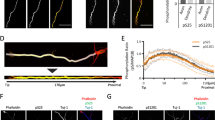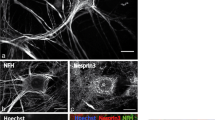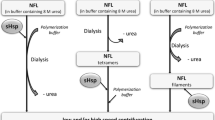Summary
-
1.
Recent examination of the hypothesis that distinctly phosphorylated NF-H isoforms exist in different types of neurons revealed that the extent of phosphorylation of the heavy neurofilament polypeptide of bovine ventral root motor neurons is markedly higher than that of dorsal root neurons.
-
2.
In the present study we employed endoproteinase ASP-N for isolating the Lys-Ser-Pro (KSP)-rich domain of NF-H, which contains most of the NF-H phosphorylation sites.
-
3.
Treatment of NF-H with ASP-N endoproteinase results in a cascade of products, the last of which is a polypeptide with apparent molecular weight of 120 kDa. Amino terminal sequence and amino acid composition analysis revealed that this fragment contains the KSP-rich domain of NF-H.
-
4.
Treatment of ventral and dorsal root NF-H with ASP-N endoproteinase and analysis of the phosphoserine contents of the resulting 120 kDa fragments revealed that the 120 kDa fragment of ventral root NF-H is significantly more phosphorylated than that of dorsal root NF-H.
Similar content being viewed by others
References
Belgrund, A. M., and Ryugo, D. K. (1991). Neurofilament antibodies and spinal ganglion neurons of mammalian cochlea.J. Comp. Neurol. 306:393–408.
Campbell, M. J., and Morrison, J. H. (1989). Monoclonal antibody to neurofilament protein (SM132) labels a subpopulation of pyramidal neurons in the human and monkey neocortex.J. Comp. Neurol. 282:191–205.
Carden, M. J., Schlaepfer, W. W., and Lee, V. M.-Y. (1985). The structure, biochemical properties and immunogenicity of neurofilament peripheral regions are determined by phosphorylation state.J. Biol. Chem. 260:9805–9817.
Carden, M. J., Trojanowski, J. Q., Schlaepfer, W. W., and Lee, V. M.-Y. (1987). Two stage expression of neurofilament polypeptides during rat neurogenesis with early establishment of adult phosphorylation patterns.J. Neurosci. 27:3489–3504.
Chertoff, R., Soussan, L., Roder, H., and Michaelson, D. M. (1995). Phosphorylation and dephosphorylation of the heavy neurofilaments protein NF-H.Cell. Mol. Neurobiol. 15:259–271.
Clark, E. A., and Lee, V. M.-Y. (1991). Dynamics of mammalian high-molecular-weight neurofilament subunit phosphorylation in cultured rat sympathetic neurons.J. Neurosci. Res. 30:116–123.
Dahl, D. (1983). Immunohistochemical differences between neurofilaments in perikarya, dendrites, and axons.Exp. Cell Res. 149:397–408.
Dahl, D., Labkovsky, B., and Bignami, A. (1988). Neurofilament phosphorylation in axons and perikarya: Immunofluorescence study of the rat spinal cord and dorsal root ganglia with monoclonal antibodies.J. Comp. Neurol. 271:445–450.
Dahl, D., Gilad, L. H., Mazzini, L., and Bigmani, A. (1992). Effect of the substrate on neurofilament phosphorylation in mixed culturs or rat embryo spinal cord and dorsal root ganglia.Int. J. Dev. Neurosci. 10(2):111–119.
de Waegh, S. M., Lee, V. M.-Y., and Brady, S. (1992). Local modulation of neurofilament phosphorylation axonal caliber and slow axonal transport by myelinating Schwann cells.Cell 62:451–463.
Dosemeci, A., and Pont, H. C. (1992). Association of cyclic AMP dependent protein kinase with neurofilaments.Biochem. J. 282:477–481.
Elhanny, E., Jaffe, H., Link, W. T., Sheeley, D. M., Gainer, H., and Harish, C. (1994). Identification of endogenously phosphorylated sites in KSP motifs of the high molecular weight rat neurofilaments.J. Neurochem. 63:2324–2335.
Faigon, N., Hadas, E., Alroy, G., Chapman, H., Auerbach, J. M., and Michaelson, D. M. (1991). Monoclonal antibodies to the heavy neurofilament subunit (NF-H) ofTorpedo cholinergic neurons.J. Neurosci. Res. 29:490–498.
Figliwicz, D. A., Roulian, G. A., Rizus, A., and Julien, J.-P. (1993). Polymorphism in the multi-phosphorylation domain of the human neurofilament heavy-subunit-encoding gene.Gene 132:297–300.
Geisler, N., and Weber, K. (1981). Self-assemblyin vitro of the 68,000 molecular weight component of the mammalian neurofilament triplet proteins into intermediate-sized filaments.J. Mol. Biol. 151:565–571.
Geisler, N., Kaufmann, E., Fischer, S., Plessmann, U., and Weber, K. (1983). Neurofilament architecture combines structural principles of intermediate filaments with carboxy-terminal extensions increasing in size between triplet proteins.EMBO J. 2:1295–1302.
Geisler, N., Fischer, S., Vandekerckhove, F., van Damme, J., Plessmann, U., and Weber, K. (1985). Protein chemical characterization of NF-H, the largest mammalian neurofilament component, intermediate filament-type sequences followed by a unique carboxy terminal extension.EMBO J. 4:57–63.
Gonda, Y., Nishizawa, Y., Ando, S., Kitamura, S., Minoura, Y., Nshi, Y., and Inagaki, M. (1990). Involvement of protein kinase C in the regulation of assembly-disassembly of neurofilamentin vitro.Biochem. Bipphys. Res. Commun. 167:1316–1325.
Hirokawa, N., Glicksman, M., and Willard, M. (1984). Organization of mammalian neurofilament polypeptides within the neuronal cytoskeleton.J. Cell Biol. 98:1523–1536.
Julien, J.-P., Smoluk, G. D., and Muspynski, W. E. (1983). Characteristics of protein kinase activity associated with rat neurofilament preparations.Biochim. Biophys. Acta 755:25–31.
Laemmli, U. K. (1970). Cleavage of structural proteins during the assembly of the head of bacteriophage T4.Nature 227:680–685.
Lee, V. M.-Y., Carden, M. J., Schlaepfer, W. W., and Trojanowski, J. Q. (1987). Monoclonal antibodies distinguish several differentially phosphorylated states of the two largest rat neurofilament subunits (NF-H and NF-M) and demonstrate their existence in the normal nervous system of adult rats.J. Neurosci. 7:3474–3488.
Lee, V. M.-Y., Otvos, L., Carden, M., Hollosi, M., Dietzschold, B., Lazzarini, R. (1988). Identification of the major multiphosphorylation site in mammalian neurofilaments.Proc. Natl. Acad. Sci. USA 185:1998–2002.
Lees, J. F., Shneidman, P. S., Skuntz, S. F., Carden, M. J., and Lazzarini, R. A. (1988). The structure and organization of the human heavy neurofilaments subunit (NF-H) and the gene encoding it.EMBO J. 7:1947–1995.
Mahboub, S., Hemen, B., Defossez, A., Delacourt, A., and Han, K.-K. (1986). Biochemical and immunological studies of bovine and porcine neurofilament triplet proteins by peptide mapping after cyanogen bromide cleavage.Comp. Biochem. Physiol. 85B:299–306.
Murthy, L. R., and Iqbal, K. (1991). Measurement of picomoles of phosphoamino acids by high performance liquid chromatography.Anal. Biochem. 193:199–205.
Nixon, R. A., and Sihag, R. K. (1991). Neurofilament phosphorylation: A new look at regulation and function.Trends Neurosci. 14:501–506.
Robinson, P. A., and Anderton, B. H. (1988). Neurofilament probes—a review of neurofilament distribution and biology.Rev. Neurosci. 2:1–41.
Robinson, P. A., Wion, D., and Anderton, B. H. (1986). Isolation of a cDNA for rat heavy neurofilament polypeptides (NF-H).FEBS Lett. 209:203–205.
Roder, H. M., and Ingram, V. M. (1991). Two novel kinases phosphorylate tau and the KSP site of heavy neurofilament subunits in high stoichiometric ratios.J. Neurosci. 11:3325–3343.
Shneidman, P. S., Carden, M. J., Lees, J. F., and Lazzarini, R. A. (1988). The structure of the largest murine neurofilament protein (NF-H) as revealed by cDNA and genomic sequences.Mol. Brain Res. 4:217–231.
Sihag, R. K., and Nixon, R. A. (1990). Phosphorylation of the amino terminal head domain of the middle molecule mass 145 kDa subunit of neurofilaments.J. Biol. Chem. 265:4166–4171.
Soppet, D. R., Beasley, L. L., and Willard, M. B. (1992). Endline for unequal crossing over in the evolution of the neurofilament polypeptide H.J. Biol. Chem. 267:17354–17361.
Sorensen, K., and Brodbeck, U. (1986). Assessment of coating efficiency in ELISA plates by direct protein determination.J. Immunol. Methods 95:291–293.
Soussan, L., Barzilai, A., and Michaelson, D. M. (1994). Distinctly phosphorylated neurofilaments in different classes of neurons.J. Neurochem. 62:770–776.
Steinent, D. M., and Roop, D. R. (1988). Molecular and cellular biology of intermediate filaments.Annu. Rev. Biochem. 57:593–625.
Sternberger, L. A., and Sternberger, N. H. (1983). Monoclonal antibodies distinguish phosphorylated and nonphosphorylated forms of neurofilamentsin situ.Proc. Natl. Acad. Sci. USA 80:6126–6130.
Szaro, B. G., Whitnall, M. H., and Gainer, H. (1990). Phosphorylation dependent epitopes on neurofilament proteins and neurofilament densities differ in axons in the corticospinal and primary sensory dorsal column tracts in the rat spinal cord.J. Comp. Neurol. 302:220–235.
Tokui, T., Yamamuchi, T., Yano, T., Nishi, Y., Kusagawa, M., Yatani, R., and Inagaki, M. (1990). Ca2+-calmodulin-dependent protein kinase II phosphorylates various types of non-epithelial intermediate filament proteins.Biochem. Biophys. Res. Commun. 169:896–904.
Vickers, J. C., Costa, M., Vitadello, M., Dahl, D., and Marotta, C. A. (1990). Neurofilament protein-triplet immunoreactivity in distinct subpopulations of peptide containing neurons in the guinea-pig coeliac ganglion.Neuroscience 39:743–759.
Wible, B. A., Smith, K. E., and Angelides, K. J. (1989). Resolution and purification of a neurofilament-specific kinase.Proc. Natl. Acad. Sci. USA 86:720–724.
Yagihashi, S., Kamijo, M., and Watanabe, K. (1990). Reduced myelinated fiber size correlates with loss of axonal neurofilaments in peripheral nerve of chronically streptozotocin diabetic rats.Am. J. Pathol. 136:1365–1373.
Author information
Authors and Affiliations
Rights and permissions
About this article
Cite this article
Soussan, L., Admon, A., Aharoni, A. et al. Isolation and characterization of the highly phosphorylated repeat domain of distinct heavy neurofilament subunit (NF-H) isoforms. Cell Mol Neurobiol 16, 463–477 (1996). https://doi.org/10.1007/BF02150227
Received:
Accepted:
Issue Date:
DOI: https://doi.org/10.1007/BF02150227




